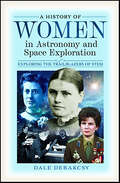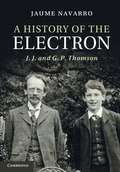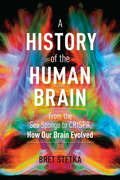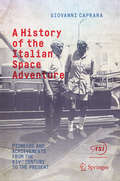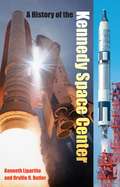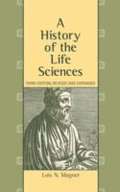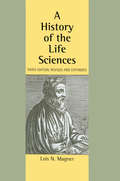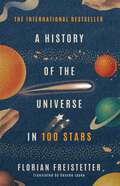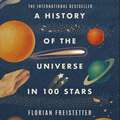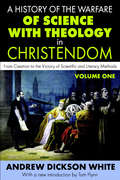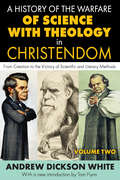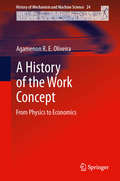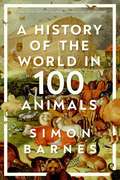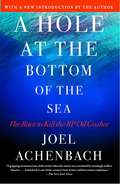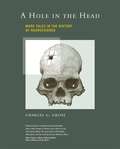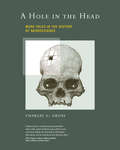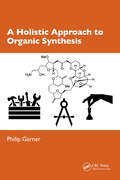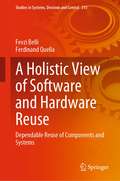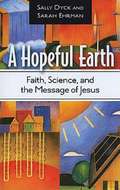- Table View
- List View
A History of Women in Astronomy and Space Exploration: Exploring the Trailblazers of STEM
by Dale DeBakcsyFor the last four hundred years, women have played a part far in excess of their numerical representation in the history of astronomical research and discovery. It was a woman who gave us our first tool for measuring the distances between stars, and another who told us for the first time what those stars were made of. It was women who first noticed the rhythmic noise of a pulsar, the temperature discrepancy that announced the existence of white dwarf stars, and the irregularities in galactic motion that informed us that the universe we see might be only a small part of the universe that exists. And yet, in spite of the magnitude of their achievements, for centuries women were treated as essentially second class citizens within the astronomical community, contained in back rooms, forbidden from communicating with their male colleagues, provided with repetitive and menial tasks, and paid starvation wages. This book tells the tale of how, in spite of all those impediments, women managed, by sheer determination and genius, to unlock the secrets of the night sky. It is the story of some of science's most hallowed names - Maria Mitchell, Caroline Herschel, Vera Rubin, Nancy Grace Roman, and Jocelyn Bell-Burnell - and also the story of scientists whose accomplishments were great, but whose names have faded through lack of use - Queen Seondeok of Korea, who built an observatory in the 7th century that still stands today, Wang Zhenyi, who brought heliocentrism to China, Margaret Huggins, who perfected the techniques that allowed us to photograph stellar spectra and thereby completely changed the direction of modern astronomy, and Hisako Koyama, whose multi-decade study of the sun's surface is as impressive a feat of steadfast scientific dedication as it is a rigorous and valuable treasure trove of solar data. A History of Women in Astronomy and Space Exploration is not only a book, however, of those who study space, but of those who have ventured into it, from the fabled Mercury 13, whose attempt to join the American space program was ultimately foiled by betrayal from within, to mythical figures like Kathryn Sullivan and Sally Ride, who were not only pioneering space explorers, but scientific researchers and engineers in their own rights, aided in their work by scientists like Mamta Patel Nagaraja, who studied the effects of space upon the human body, and computer programmers like Marianne Dyson, whose simulations prepared astronauts for every possible catastrophe that can occur in space. Told through over 130 stories spanning four thousand years of humanity's attempt to understand its place in the cosmos, A History of Women in Astronomy and Space Exploration brings us at last the full tale of women's evolution from instrument makers and calculators to the theorists, administrators, and explorers who have, while receiving astonishingly little in return, given us, quite literally, the universe.
A History of the Electron
by Jaume NavarroTwo landmarks in the history of physics are the discovery of the particulate nature of cathode rays (the electron) by J. J. Thomson in 1897 and the experimental demonstration by his son G. P. Thomson in 1927 that the electron exhibits the properties of a wave. Together, the Thomsons are two of the most significant figures in modern physics, both winning Nobel prizes for their work. This book presents the intellectual biographies of the father-and-son physicists, shedding new light on their combined understanding of the nature of electrons and, by extension, of the continuous nature of matter. It is the first text to explore J. J. Thomson's early and later work, as well as the role he played in G. P. Thomson's education as a physicist and how he reacted to his son's discovery of electron diffraction. This fresh perspective will interest academics and graduate students working in the history of early twentieth-century physics.
A History of the Human Brain: From the Sea Sponge to CRISPR, How Our Brain Evolved
by Bret Stetka&“A History of the Human Brain is a unique, enlightening, and provocative account of the most significant question we can ask about ourselves.&” —Richard Wrangham, author of The Goodness Paradox Just 125,000 years ago, humanity was on a path to extinction, until a dramatic shift occurred. We used our mental abilities to navigate new terrain and changing climates. We hunted, foraged, tracked tides, shucked oysters—anything we could do to survive. Before long, our species had pulled itself back from the brink and was on more stable ground. What saved us? The human brain—and its evolutionary journey is unlike any other. In A History of the Human Brain, Bret Stetka takes us on this far-reaching journey, explaining exactly how our most mysterious organ developed. From the brain&’s improbable, watery beginnings to the marvel that sits in the head of Home sapiens today, Stetka covers an astonishing progression, even tackling future brainy frontiers such as epigenetics and CRISPR. Clearly and expertly told, this intriguing account is the story of who we are. By examining the history of the brain, we can begin to piece together what it truly means to be human.
A History of the Italian Space Adventure: Pioneers and Achievements from the XIVth Century to the Present
by Giovanni CapraraThis well-documented and fascinating book tells how, over the centuries, a series of visionaries, scientists, technologists, and politicians fostered the involvement of Italy in space exploration. The lives of these pioneers was often far from easy, yet they persevered. The fruits of their efforts can today be witnessed in Italy’s success within the cutting-edge space sector. Italy’s history in space started at the end of the fourteenth century and continued with the development of fireworks. Later, the nineteenth century marked the beginning of research into rockets in a more scientific way. After World War II, rocket technology was advanced with the aid of German scientists, and in the 1960s Luigi Broglio, the father of Italian space exploration, designed the San Marco satellite. In 1979 the first Italian Space Plan was launched, but it was the foundation of the Italian Space Agency in 1988 that kick-started a program of exploration in various fields of cosmic research. The outcome was construction of the Vega launcher and collaboration in the International Space Station. Now the Italian space industry stands ready to play an important role in the Gateway orbital station. All of this history, and more, is explored in this riveting book.
A History of the Kennedy Space Center
by Kenneth Lipartito Orville ButlerThis first comprehensive history of the Kennedy Space Center, NASA's famous launch facility located at Cape Canaveral, Florida, reveals the vital but largely unknown work that takes place before the rocket is lit. Though the famous Vehicle Assembly Building and launch pads dominate the flat Florida landscape at Cape Canaveral and attract 1.5 million people each year to its visitor complex, few members of the public are privy to what goes on there beyond the final outcome of the flaring rocket as it lifts into space. With unprecedented access to a wide variety of sources, including the KSC archives, other NASA centers, the National Archives, and individual and group interviews and collections, Lipartito and Butler explore how the methods and technology for preparing, testing, and launching spacecraft have evolved over the last 45 years. Their story includes the Mercury and Gemini missions, the Apollo lunar program, the Space Shuttle, scientific missions and robotic spacecraft, and the International Space Station, as well as the tragic accidents of Challenger and Columbia. Throughout, the authors reveal the unique culture of the people who work at KSC and make Kennedy distinct from other parts of NASA.
A History of the Life Sciences
by Lois N. MagnerA clear and concise survey of the major themes and theories embedded in the history of life science, this book covers the development and significance of scientific methodologies, the relationship between science and society, and the diverse ideologies and current paradigms affecting the evolution and progression of biological studies. The author discusses cell theory, embryology, physiology, microbiology, evolution, genetics, and molecular biology; the Human Genome Project; and genomics and proteomics. Covering the philosophies of ancient civilizations to modern advances in genomics and molecular biology, the book is a unique and comprehensive resource.
A History of the Life Sciences, Revised and Expanded
by Lois N. MagnerA clear and concise survey of the major themes and theories embedded in the history of life science, this book covers the development and significance of scientific methodologies, the relationship between science and society, and the diverse ideologies and current paradigms affecting the evolution and progression of biological studies. The author d
A History of the Medicines We Take: From Ancient Times to Present Day
by Anthony C. Cartwright N Anthony ArmstrongA fascinating account of poultices, pills, and prescriptions over the centuries and how they’ve been developed and delivered.This lively account follows the development of medicines from traces of herbs found with the remains of Neanderthal man, to prescriptions written on clay tablets from Mesopotamia in the third millennium BC, to pure drugs extracted from plants in the nineteenth century, and to the latest biotechnology antibody products. In addition, it tells the stories behind historical figures in medicine, such as Christopher Wren, who gave the first intravenous injection in 1656, and William Brockedon, who invented the tablet in 1843, as well as recounting the changes in patterns of prescribing from simple dosage forms—such as liquid mixtures, pills, ointments, lotions, poultices, powders for treating wounds, inhalations, eye drops, enemas, pessaries, and suppositories mentioned in the Egyptian Ebers papyrus of 1550 BCE—to the complex tablets, injections, and inhalers in current use. A typical pharmacy now dispenses about as many prescriptions in a working day as a mid-nineteenth-century chemist did in a whole year. This history sheds light on the scientific progress made over centuries that led to the medical miracles of the modern world.
A History of the Mind and Mental Health in Classical Greek Medical Thought
by Chiara ThumigerThe Hippocratic texts and other contemporary medical sources have often been overlooked in discussions of ancient psychology. They have been considered to be more mechanical and less detailed than poetic and philosophical representations, as well as later medical texts such as those of Galen. This book does justice to these early medical accounts by demonstrating their richness and sophistication, their many connections with other contemporary cultural products and the indebtedness of later medicine to their observations. In addition, it reads these sources not only as archaeological documents but also in the light of methodological discussions that are fundamental to the histories of psychiatry and psychology. As a result of this approach, the book will be important for scholars of these disciplines as well as those of Greek literature and philosophy, strongly advocating the relevance of ancient ideas to modern debates.
A History of the Solar System
by Claudio Vita-FinziThis well illustrated book presents a compact history of the Solar System from its dusty origins 4,600,000 years ago to the present day. Its primary aim is to show how the planets and their satellites, comets, meteors, interplanetary dust, solar radiation and cosmic rays continually interact, sometimes violently, and it reflects humanity's progress in exploring and interpreting this history. The book is intended for a general readership at a time when human and robotic exploration of space is often in the news and should also appeal to students at all levels. It covers the essentials but refers to a large literature which can be accessed via the internet.
A History of the Universe in 100 Stars
by Florian Freistetter'Inventive [...] done beautifully' - TLSFrom the Big Bang to the Gaia Mission, this is a very personal history of the universe through the author's favourite 100 stars.Astronomer Florian Freistetter has chosen 100 stars that have almost nothing in common. Some are bright and famous, some shine so feebly you need a huge telescope. There are big stars, small stars, nearby stars and faraway stars. Some died a while ago, others have not even yet come into being. Collectively they tell the story of the whole world, according to Freistetter. There is Algol, for example, the Demon Star, whose strange behaviour has long caused people sleepless nights. And Gamma Draconis, from which we know that the earth rotates around its own axis. There is also the star sequence 61 Cygni, which revealed the size of the cosmos to us.Then there are certain stars used by astronomers to search for extra-terrestrial life, to explore interstellar space travel, or to explain why the dinosaurs became extinct.In 100 short, fascinating and entertaining chapters, Freistetter not only reveals the past and future of the cosmos, but also the story of the people who have tried to understand the world in which we live.
A History of the Universe in 100 Stars
by Florian FreistetterFrom the Big Bang to the Gaia Mission, this is a very personal history of the universe through the author's favourite 100 stars.Astronomer Florian Freistetter has chosen 100 stars that have almost nothing in common. Some are bright and famous, some shine so feebly you need a huge telescope. There are big stars, small stars, nearby stars and faraway stars. Some died a while ago, others have not even yet come into being. Collectively they tell the story of the whole world, according to Freistetter. There is Algol, for example, the Demon Star, whose strange behaviour has long caused people sleepless nights. And Gamma Draconis, from which we know that the earth rotates around its own axis. There is also the star sequence 61 Cygni, which revealed the size of the cosmos to us.Then there are certain stars used by astronomers to search for extra-terrestrial life, to explore interstellar space travel, or to explain why the dinosaurs became extinct.In 100 short, fascinating and entertaining chapters, Freistetter not only reveals the past and future of the cosmos, but also the story of the people who have tried to understand the world in which we live.(P)2021 Quercus Editions Limited
A History of the Warfare of Science with Theology in Christendom: Volume 1, From Creation to the Victory of Scientific and Literary Methods
by Andrew WhiteGiven the powerful and forthright title of Andrew Dickson White's classic study, it is best to make clear his own sense of the whole as given in the original 1896 edition: "My conviction is that science, though it has evidently conquered dogmatic theology based on biblical texts and ancient modes of thought, will go hand in hand with religion, and that although theological control will continue to diminish, religion as seen in the recognition of a 'power in the universe, not ourselves, which makes for righteousness' and in the love of God and of our neighbor, will steadily grow stronger and stronger, not only in the American institutions of learning, but in the world at large." White began to assemble his magnum opus, a two volume work first published in 1896 as A History of the Warfare of Science with Theology in Christendom. In correspondence he wrote that he intended the work to stake out a position between such religious orthodoxy as John Henry Newman's on one side and such secular scoffing as Robert Ingersoll's on the other. Historian Paul Carter declared that this book did as much as any other published work "toward routing orthodoxy in the name of science." Insofar as science and religion came to be widely viewed as enemies, with science holding the moral high ground, White inadvertently, became one of the most effective and influential advocates for unbelief.
A History of the Warfare of Science with Theology in Christendom: Volume 2, From Creation to the Victory of Scientific and Literary Methods
by J.M. CohenGiven the powerful and forthright title of Andrew Dickson White's classic study, it is best to make clear his own sense of the whole as given in the original 1896 edition: "My conviction is that science, though it has evidently conquered dogmatic theology based on biblical texts and ancient modes of thought, will go hand in hand with religion, and that although theological control will continue to diminish, religion as seen in the recognition of a 'power in the universe, not ourselves, which makes for righteousness' and in the love of God and of our neighbor, will steadily grow stronger and stronger, not only in the American institutions of learning, but in the world at large." White began to assemble his magnum opus, a two volume work first published in 1896 as A History of the Warfare of Science with Theology in Christendom. In correspondence he wrote that he intended the work to stake out a position between such religious orthodoxy as John Henry Newman's on one side and such secular scoffing as Robert Ingersoll's on the other. Historian Paul Carter declared that this book did as much as any other published work "toward routing orthodoxy in the name of science." Insofar as science and religion came to be widely viewed as enemies, with science holding the moral high ground, White inadvertently, became one of the most effective and influential advocates for unbelief.
A History of the Work Concept: From Physics to Economics (History of Mechanism and Machine Science #24)
by Agamenon R. E. OliveiraThis book traces the history of the concept of work from its earliest stages and shows that its further formalization leads to equilibrium principle and to the principle of virtual works, and so pointing the way ahead for future research and applications. The idea that something remains constant in a machine operation is very old and has been expressed by many mathematicians and philosophers such as, for instance, Aristotle. Thus, a concept of energy developed. Another important idea in machine operation is Archimedes' lever principle. In modern times the concept of work is analyzed in the context of applied mechanics mainly in Lazare Carnot mechanics and the mechanics of the new generation of polytechnical engineers like Navier, Coriolis and Poncelet. In this context the word "work" is finally adopted. These engineers are also responsible for the incorporation of the concept of work into the discipline of economics when they endeavoured to combine the study of the work of machines and men together.
A History of the World in 100 Animals
by Simon BarnesFully illustrated in color, a fascinating exploration of the one hundred animals that have had the most profound influence on humanity throughout the ages.We are not alone. We are not alone on the planet. We are not alone in the countryside. We are not alone in cities. We are not alone in our homes. We are humans and we love the idea of our uniqueness. But the fact is that we humans are as much members of the animal kingdom as the cats and dogs we surround ourselves with, the cows and the fish we eat, and the bees who pollinate so many of our food-plants. In The History of the World in 100 Animals, award-winning author Simon Barnes selects the one hundred animals who have had the greatest impact on humanity and on whom humanity has had the greatest effect. He shows how we have domesticated animals for food and for transport, and how animals powered agriculture, making civilisation possible. A species of flea came close to destroying human civilisation in Europe, while the slaughter of a species of bovines was used to create one civilisation and destroy another. He explains how pigeons made possible the biggest single breakthrough in the history of human thought. In short, he charts the close relationship between humans and animals, finding examples from around the planet that bring the story of life on earth vividly to life, with great insight and understanding. The heresy of human uniqueness has led us across the millennia along the path of destruction. This book, beautifully illustrated throughout, helps us to understand our place in the world better, so that we might do a better job of looking after it. That might save the polar bears, the modern emblem of impending loss and destruction. It might even save ourselves.
A Hole at the Bottom of the Sea: The Race to Kill the BP Oil Gusher
by Joel AchenbachThe struggle to kill the BP Macondo gusher in the Gulf of Mexico is the Apollo 13 of our time—this is the thrilling story of the nightmare well and the men who conquered it in dangerous waters.Suspensful and illuminating, Joel Achenbach offers a groundbreaking account of the Deepwater Horizon disaster and what came after. The tragic explosion on the huge drilling rig in April 2010 killed eleven men and triggered an environmental disaster. As a gusher of crude surged into the Gulf&’s waters, BP engineers and government scientists—awkwardly teamed in Houston—raced to devise ways to plug the Macondo well. Achenbach, a veteran reporter for The Washington Post and acclaimed science writer for National Geographic, moves beyond the blame game to tell the gripping story of what it was like behind the scenes, moment by moment, in the struggle to kill Macondo. Here are the controversies, the miscalculations, the frustrations, and ultimately the technical triumphs of men and women who worked out of sight and around the clock for months to find a way to plug the well. The government did not have the means to solve the problem; only the private sector had the tools, and it didn&’t have the right ones as the country became haunted by Macondo&’s black plume, which was omnipresent on TV and the internet. Remotely operated vehicles, the spaceships of the deep, had to perform the challenging technical maneuvers on the seafloor. Engineers choreographed this robotic ballet and crammed years of innovation into a single summer. As he describes the drama in Houston, Achenbach probes the government investigation into what went wrong in the deep sea. A confounding mystery and an engineering whodunit, the lessons of this tragedy can be applied broadly to all complex enterprises and should make us look more closely at the highly engineered society that surrounds us.
A Hole in the Head
by Charles G. GrossNeuroscientist Charles Gross has been interested in the history of his field since his days as an undergraduate. A Hole in the Head is the second collection of essays in which he illuminates the study of the brain with fascinating episodes from the past. This volume's tales range from the history of trepanation (drilling a hole in the skull) to neurosurgery as painted by Hieronymus Bosch to the discovery that bats navigate using echolocation. The emphasis is on blind alleys and errors as well as triumphs and discoveries, with ancient practices connected to recent developments and controversies. Trepanation, for example, originated in Paleolithic societies and is now promoted on a variety of Web sites as a means of "enhancing" consciousness. Gross first reaches back into the beginnings of neuroscience, discussing such topics as debates over the role of the brain (as opposed to the heart) in cognition and the relationship of vision to ideas about the "evil eye." He then takes up the interaction of art and neuroscience, exploring, among other things, Rembrandt's "Anatomy Lesson" paintings--one of which prefigured the poses in a famous photograph of the dead Che Guevara. Finally, Gross examines discoveries by scientists whose work was scorned in their own time but proven correct in later eras, including Claude Bernard's argument for the importance of the constancy of the internal environment and Joseph Altman's pioneering (and ignored) discovery of adult neurogenesis.
A Hole in the Head: More Tales in the History of Neuroscience (The\mit Press Ser.)
by Charles G. GrossEssays on great figures and important issues, advances and blind alleys—from trepanation to the discovery of grandmother cells—in the history of brain sciences. Neuroscientist Charles Gross has been interested in the history of his field since his days as an undergraduate. A Hole in the Head is the second collection of essays in which he illuminates the study of the brain with fascinating episodes from the past. This volume's tales range from the history of trepanation (drilling a hole in the skull) to neurosurgery as painted by Hieronymus Bosch to the discovery that bats navigate using echolocation. The emphasis is on blind alleys and errors as well as triumphs and discoveries, with ancient practices connected to recent developments and controversies. Gross first reaches back into the beginnings of neuroscience, then takes up the interaction of art and neuroscience, exploring, among other things, Rembrandt's “Anatomy Lesson” paintings, and finally, examines discoveries by scientists whose work was scorned in their own time but proven correct in later eras.
A Holistic Approach to Organic Synthesis
by Philip GarnerSynthesis is one of the distinguishing features of chemistry as a science. It is the synthetic chemist who uses their intimate understanding of molecular structure and properties to produce materials of great value to society. Thus, it is important for students of chemistry to study synthesis and acquire a working knowledge that enables them to address the following question: given a specific molecular target, how does one formulate a plan for its synthesis? This synthesis primer provides students who have taken introductory organic chemistry with a set of tools that can be used to plan a synthesis. It may be used in conjunction with a synthetic methods course, or it can stand alone.Features: Provides students who have taken introductory organic chemistry with a set of tools that can be used to plan a synthesis Serves to help organic chemists at all levels to better understand published syntheses Focuses on natural products, their complexity, and diverse structures which challenge and inspire the chemists preparing them Succinct, readable treatment of important concepts and applications geared towards advanced undergraduates and graduate students Each synthesis covered begins with a brief discussion of the target molecule and challenges they present, followed by retrosynthetic considerations
A Holistic View of Software and Hardware Reuse: Dependable Reuse of Components and Systems (Studies in Systems, Decision and Control #315)
by Ferdinand Quella Fevzi BelliThis book focuses on software reuse and the chances, dependability tests and recommendations for best reuse practice. A short introduction of the Ecodesign of hardware is given combined with the latest update of relevant EU legislation and standardization. It also describes the combination of different states of software in a E&E system in order to guarantee dependability of the product to be resold.
A Hopeful Earth: Faith, Science, and the Message of Jesus
by Sally Bishop DyckThe environment is God's creation and Christians should be at the front of the crowd when it comes to taking care of it. Yet we find ourselves in a creation crisis. A Hopeful Earth , a unique study, draws together the Christian faith of Bishop Sally Dyck and the scientific world of her niece, Sally Ehrman, to address this crisis. As these two dialogue, readers will find that these sometimes differing worldviews are both crucial to making lasting changes. They'll also discover how the church can reach out to the younger generation by joining them in the race to save the planet. A Hopeful Earth will bridge the gap between Jesus and the environment and guide readers in understanding that living as good stewards of God's creation is a significant component of what it means to follow Jesus.
A House in the Sky
by Steve JenkinsCaldecott Honor recipient Steve Jenkins shines as the author of this amusing and thorough introduction to animal homes.Turtles, birds, fish, beavers, and kangaroos are just like people--they need homes, and take up residence in unusual places. A simple main text introduces similarities between human and animal homes while sidebars detail the unique qualities of each animal and its home. Stylized yet realistic watercolor illustrations prove that nonfiction can be accurate and elegant, and readers of all ages will appreciate this layered narrative.
A Human Algorithm: How Artificial Intelligence Is Redefining Who We Are
by Flynn ColemanA groundbreaking narrative on the urgency of ethically designed AI and a guidebook to reimagining life in the era of intelligent technology.The Age of Intelligent Machines is upon us, and we are at a reflection point. The proliferation of fast–moving technologies, including forms of artificial intelligence akin to a new species, will cause us to confront profound questions about ourselves. The era of human intellectual superiority is ending, and we need to plan for this monumental shift.A Human Algorithm: How Artificial Intelligence Is Redefining Who We Are examines the immense impact intelligent technology will have on humanity. These machines, while challenging our personal beliefs and our socioeconomic world order, also have the potential to transform our health and well–being, alleviate poverty and suffering, and reveal the mysteries of intelligence and consciousness. International human rights attorney Flynn Coleman deftly argues that it is critical that we instill values, ethics, and morals into our robots, algorithms, and other forms of AI. Equally important, we need to develop and implement laws, policies, and oversight mechanisms to protect us from tech’s insidious threats.To realize AI’s transcendent potential, Coleman advocates for inviting a diverse group of voices to participate in designing our intelligent machines and using our moral imagination to ensure that human rights, empathy, and equity are core principles of emerging technologies. Ultimately, A Human Algorithm is a clarion call for building a more humane future and moving conscientiously into a new frontier of our own design.“[Coleman] argues that the algorithms of machine learning––if they are instilled with human ethics and values––could bring about a new era of enlightenment.” —San Francisco Chronicle
A Human History of Emotion: How the Way We Feel Built the World We Know
by Richard Firth-GodbehereA sweeping exploration of the ways in which emotions shaped the course of human history, and how our experience and understanding of emotions have evolved along with us. "Eye-opening and thought-provoking!&” (Gina Rippon, author of The Gendered Brain) We humans like to think of ourselves as rational creatures, who, as a species, have relied on calculation and intellect to survive. But many of the most important moments in our history had little to do with cold, hard facts and a lot to do with feelings. Events ranging from the origins of philosophy to the birth of the world&’s major religions, the fall of Rome, the Scientific Revolution, and some of the bloodiest wars that humanity has ever experienced can&’t be properly understood without understanding emotions.Drawing on psychology, neuroscience, philosophy, art, and religious history, Richard Firth-Godbehere takes readers on a fascinating and wide ranging tour of the central and often under-appreciated role emotions have played in human societies around the world and throughout history—from Ancient Greece to Gambia, Japan, the Ottoman Empire, the United States, and beyond. A Human History of Emotion vividly illustrates how our understanding and experience of emotions has changed over time, and how our beliefs about feelings—and our feelings themselves—profoundly shaped us and the world we inhabit.
